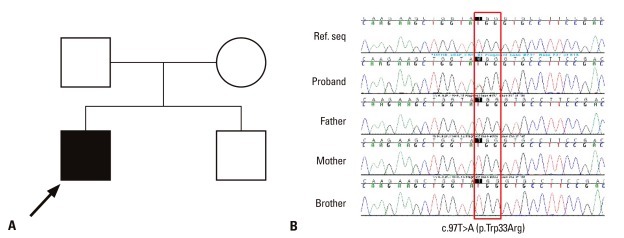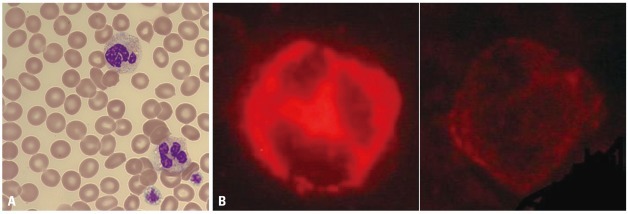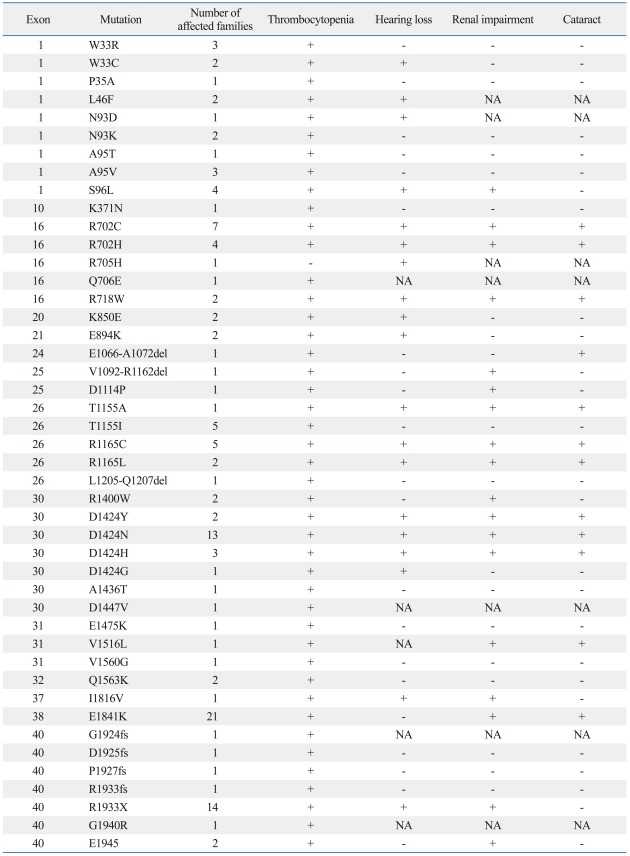Abstract
In this report, we describe a Korean patient with May-Hegglin anomaly from a mutation of the MYH9 gene. The proband was a 21-year-old man with thrombocytopenia. He did not have a bleeding tendency. His neutrophil count was normal at 7490/mm3; however, the neutrophils contained abnormal basophilic inclusions in their cytoplasm. The platelet count was decreased at 15000/mm3 with giant platelets. Coagulation test results were not remarkable. Direct sequencing of MYH9 revealed that he was heterozygous for a mutation in exon 1, which was a 97T>A substitution mutation affecting codon 33, substituting tryptophan with arginine (Trp33Arg). Family study showed that both of his parents had normal phenotype and genotypes, indicating a de novo occurrence of the mutation in the proband.
Keywords: May-Hegglin anomaly, MYH9, thrombocytopenia, Korean
INTRODUCTION
May-Hegglin anomaly (MHA) is a rare autosomal dominant disorder characterized by giant platelets and pale-blue inclusions in leukocytes. The clinical characteristics and the hereditary pattern of MHA were first described in 1909 and 1945, respectively.1,2 The mutated gene is the gene encoding myosin heavy chain 9 (MYH9) located on chromosome band 22q12-13, which is comprised of 40 exons encoding the nonmuscle myosin heavy-chain IIA (NMMHC-IIA), a cytoskeletal contractile protein.3,4 In this report, we describe a Korean patient with MHA from a missense mutation in exon 1 of MYH9.
CASE REPORT
The proband, a 21-year-old Korean soldier, was referred to Bundang CHA Medical Center because of thrombocytopenia. He had been diagnosed as having giant platelet syndrome 8 years previously in a tertiary hospital without further investigation or follow-up. Recently he was found to have thrombocytopenia on routine health checkup at an army hospital. He had no personal or familial history of a bleeding tendency.
Complete cell counts at the present visit showed a platelet count at 36000/mm3. Peripheral blood smear revealed giant platelets and basophilic oval-shaped inclusion bodies in the cytoplasm of granulocytes. Based on the history and laboratory findings, he was suspected to have MHA, one of the MYH9-related disorders. His parents and younger brother paid a visit for family study and had their blood drawn for cell counts and molecular genetic analyses (Fig. 1A).
Fig. 1.
(A) The pedigree of the patient (arrow). (B) The results of direct sequencing of MYH9 in the proband and family members. The proband was heterozygous for a missense mutation, c.97T>A, p.Trp33Arg. His parents did not have the mutation, indicating a de novo occurrence of the mutation in the proband. His brother was also homozygous for the wild-type sequence, as were his parents.
To confirm the diagnosis of May-Hegglin anomaly disease, molecular genetic analysis was performed with informed consent provided by the patient and family members. DNA was extracted from leukocytes obtained from peripheral blood using the Wizard genomic DNA purification kit (Promega, Madison, WI, USA). All exons and their flanking intronic sequences of MYH9 were amplified by polymerase chain reaction by pairs of primers designed by the authors (available upon request). Direct sequencing was performed using the same primers. The mutation identified was described according to the guidelines by the Human Gene Variation Society (http://www.hgvs.org/mutnomen/), having the A of the ATG-translation initiation codon as +1 at the nucleotide level and the 1st Met as +1 at the protein level. The direct sequencing of the MYH9 gene in the patient showed that he was heterozygous for a missense mutation in exon 1 of MYH9. The mutation was a transversion variation (c.97T>A) substituting the 33rd residue tryptophan with arginine (p.Trp33Arg) (Fig. 1B).
Wright-Giemsa stain of peripheral blood showed cytoplasmic inclusion in neutrophils (Fig. 2A). Immunofluorescence analysis of neutrophil NMMHC-IIA showed abnormal diffuse NMMHC-IIA localization, with several circular to oval cytoplasmic inclusions (Fig. 2B). The family study showed that both of his parents and his brother had normal phenotype and genotypes, indicating a de novo occurrence of the mutation in the proband.
Fig. 2.
(A) Cytoplasmic inclusion in neutrophils (Wright-Giemsa ×1000). (B) Diffuse granular pattern of fluorescence signals from anti-NMMHC-A antibody in neutrophils.
DISCUSSION
Mutations in the MYH9 gene are responsible for a group of related thrombocytopenias: May-Hegglin anomaly, Sebastian syndrome, Fechtner syndrome, and Epstein syndrome, based on the morphologic aspects of Döhle-like bodies and the combination of different clinical findings at the time of diagnosis. These disorders are characterized by mild to severe thrombocytopenia with large-sized platelets. The typical clinical manifestation is macrothrombocytopenia; however, the bleeding tendency is usually moderate. Thrombocytopenia ranges from mild to severe and remains stable in an individual throughout their lifetime. Other clinical features may include high tone deafness, cataracts, leukocyte inclusions, and kidney disease leading in some cases to renal failure.
The MYH9 gene encodes the nonmuscle myosin heavy chain, class IIA. To date, 43 different mutations of the MYH9 gene in more than 200 families have been identified.5-7 Most causative MYH9 mutations reported to date have been missense, although in-frame deletions of a few amino acids, as well as nonsense and frameshift mutations have also been reported.8,9 Some of the reported mutations have occurred de novo as with our case. The proportion of cases caused by de novo mutations is 20-38%.10 In Korea, until recently, seven families of MHA have been identified.11-18 Of them, mutation analysis was performed in only two families and revealed previously reported mutations.17,18
In this report, we described a patient with MHA due to a missense mutation in the MYH9 gene. The mutation was a T-to-A substitution in exon 1 of MYH9 (c.97T>A), replacing tryptophan of the codon 33 with arginine (p.Trp33Arg) on the head domain of NMMHC-IIA. Two cases of Trp33Arg have also recently been reported in patients with MHA, as abstracts,5,6 and this is the third report in the world of this mutation and the first in Asia, to the best of our knowledge. Until now, 43 mutations in 14 different exons have been described.5-7,16,19-24 Exons 1-19 encode for the head and neck domains of NMMHC-IIA , while exons 20-40 encode the tail portion of the protein.7 Exon 1, 16, 26, 30 and 40 are relatively frequent sites of mutations. The mutation in our patient occurred on the actin binding site of the head domain of NMMHC-IIA at exon 1.
Previous studies reported that patients with a mutation in exon 1 of MYH9 had a high frequency of hearing or renal impairment (Table 1).5-7,17,19-24 The patient in the present report showed no evidence of hearing or renal impairment. However, further monitoring is needed for the possible development of these complications.
Table 1.
NA, no data available; fs, frameshift; del, deletion.
ACKNOWLEDGEMENTS
This work was supported by the research fund from Korea Research Foundation (KRF-2008-313-E00281).
Footnotes
The authors have no financial conflicts of interest.
References
- 1.May R. Leukozyteneinschlusse. Dtsch Arch Klin Med. 1909;96:1–6. [Google Scholar]
- 2.Hegglin R. Gleichzeitige konstitutionelle Veranderungen an Neutrophilen und Thrombozyten. Helv Med Acta. 1945;12:439–440. [PubMed] [Google Scholar]
- 3.Kelley MJ, Jawien W, Ortel TL, Korczak JF. Mutation of MYH9, encoding non-muscle myosin heavy chain A, in May-Hegglin anomaly. Nat Genet. 2000;26:106–108. doi: 10.1038/79069. [DOI] [PubMed] [Google Scholar]
- 4.Seri M, Cusano R, Gangarossa S, Caridi G, Bordo D, Lo Nigro C, et al. Mutations in MYH9 result in the May-Hegglin anomaly, and Fechtner and Sebastian syndromes. The May-Heggllin/Fechtner Syndrome Consortium. Nat Genet. 2000;26:103–105. doi: 10.1038/79063. [DOI] [PubMed] [Google Scholar]
- 5.Saposnik B, Binard S, Elbaz S, Trichet C, Pouplard C, Roussel-Robert V, et al. MYH9-related disease (MYH9-RD), from one thing to the other: 11 novel mutations and 3 new exons affected. J Thromb Haemost. 2009;7 Abstract AS-TH-043. [Google Scholar]
- 6.Al-Marwani AO, Pearson D, Wagner B, Ong AC, Makris M, Daly ME. Molecular genetic basis of inherited thrombocytopenia. J Thromb Haemost. 2009;7 Abstract PP-MO-075. [Google Scholar]
- 7.Althaus K, Greinacher A. MYH9-related platelet disorders. Semin Thromb Hemost. 2009;35:189–203. doi: 10.1055/s-0029-1220327. [DOI] [PubMed] [Google Scholar]
- 8.Pecci A, Panza E, Pujol-Moix N, Klersy C, Di Bari F, Bozzi V, et al. Position of nonmuscle myosin heavy chain IIA (NMMHC-IIA) mutations predicts the natural history of MYH9-related disease. Hum Mutat. 2008;29:409–417. doi: 10.1002/humu.20661. [DOI] [PubMed] [Google Scholar]
- 9.Pecci A, Canobbio I, Balduini A, Stefanini L, Cisterna B, Marseglia C, et al. Pathogenetic mechanisms of hematological abnormalities of patients with MYH9 mutations. Hum Mol Genet. 2005;14:3169–3178. doi: 10.1093/hmg/ddi344. [DOI] [PubMed] [Google Scholar]
- 10.Kunishima S, Matsushita T, Yoshihara T, Nakase Y, Yokoi K, Hamaguchi M, et al. First description of somatic mosaicism in MYH9 disorders. Br J Haematol. 2005;128:360–365. doi: 10.1111/j.1365-2141.2004.05323.x. [DOI] [PubMed] [Google Scholar]
- 11.Lee AN, Nam CH, Kim BS, Song KS. A family case of May-Hegglin anomaly. Korean J Hematol. 1992;27:195–199. [Google Scholar]
- 12.Lee MA, Kim SM, Jin JY, Kim SY. A family case of May-Hegglin anomaly. Korean J Clin Pathol. 1992;12:463–466. [Google Scholar]
- 13.Im CB, Lee JK, Kim JW, Kwon KC, Koo SH, Park JW, et al. A family case of may-hegglin anomaly. Korean J Hematol. 1993;28:157–163. [Google Scholar]
- 14.Lee JH, Park SY, Kim YS, Dai J, Kim BC. The May-Hegglin anomaly in a family. J Korean Pediatr Soc. 1994;37:1449–1452. [Google Scholar]
- 15.Lim J, Park SJ, Kim Y, Lee JW, Han K, Kang CS, et al. A family case of May-Hegglin anomaly. Korean J Hematol. 1999;34:492–495. [Google Scholar]
- 16.Kunishima S, Matsushita T, Kojima T, Amemiya N, Choi YM, Hosaka N, et al. Identification of six novel MYH9 mutations and genotype-phenotype relationships in autosomal dominant macrothrombocytopenia with leukocyte inclusions. J Hum Genet. 2001;46:722–729. doi: 10.1007/s100380170007. [DOI] [PubMed] [Google Scholar]
- 17.Song KS, Choi JR, Song JW, Ha SK. A nonsense C5797T (R1933X) mutation of MYH9 gene in a family with May-Hegglin anomaly. Korean J Hematol. 2001;36:253–256. [Google Scholar]
- 18.Back HJ, Kook H, Byun HS, Song ES, Kim SY, Lee JS, et al. MYH9-related disorder in a family: autosomal dominant epstein giant platelet syndrome. Korean J Pediatr Hematol Oncol. 2003;10:99–104. [Google Scholar]
- 19.Schleinitz N, Favier R, Mazodier K, Difeo A, Ebbo M, Veit V, et al. [The MYH9 syndrome: report of a new case with a new mutation of the MYH9 gene] Rev Med Interne. 2006;27:783–786. doi: 10.1016/j.revmed.2006.07.012. [DOI] [PubMed] [Google Scholar]
- 20.Kunishima S, Hamaguchi M, Saito H. Differential expression of wild-type and mutant NMMHC-IIA polypeptides in blood cells suggests cell-specific regulation mechanisms in MYH9 disorders. Blood. 2008;111:3015–3023. doi: 10.1182/blood-2007-10-116194. [DOI] [PubMed] [Google Scholar]
- 21.Kunishima S, Hirano K, Hamaguchi M, Saito H. Accumulation of MYH9 mRNA at leukocyte inclusion bodies in MYH9 disorders. Eur J Haematol. 2008;81:325–326. doi: 10.1111/j.1600-0609.2008.01119.x. [DOI] [PubMed] [Google Scholar]
- 22.Kunishima S, Matsushita T, Hamaguchi M, Saito H. Identification and characterization of the first large deletion of the MYH9 gene associated with MYH9 disorders. Eur J Haematol. 2008;80:540–544. doi: 10.1111/j.1600-0609.2008.01046.x. [DOI] [PubMed] [Google Scholar]
- 23.Miyajima Y, Kunishima S. Identification of the first in cis mutations in MYH9 disorder. Eur J Haematol. 2009;82:288–291. doi: 10.1111/j.1600-0609.2008.01202.x. [DOI] [PubMed] [Google Scholar]
- 24.Miyazaki K, Kunishima S, Fujii W, Higashihara M. Identification of three in-frame deletion mutations in MYH9 disorders suggesting an important hot spot for small rearrangements in MYH9 exon 24. Eur J Haematol. 2009;83:230–234. doi: 10.1111/j.1600-0609.2009.01274.x. [DOI] [PubMed] [Google Scholar]





